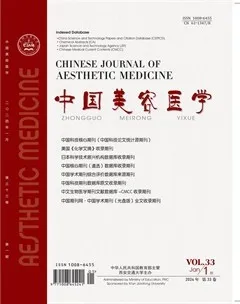外用糖皮质激素引起的皮肤萎缩及其防治研究进展
2024-02-21杨丹丹沈杰赵琪王雍孙振亮胡振林
杨丹丹 沈杰 赵琪 王雍 孙振亮 胡振林
[摘要]皮肤萎缩是外用糖皮质激素最常见的副作用之一。外用糖皮质激素引起皮肤萎缩的机制包括:抑制角质形成细胞增殖、加快其分化成熟、抑制表皮脂质合成、抑制成纤维细胞增殖,减少胶原蛋白和透明质酸钠等细胞外基质合成等。近年来,对其副作用的防治主要集中在研发糖皮质激素受体的选择性调节剂、靶向抑制促萎缩基因及相关的信号通路、联合使用其他核受体的激动剂等方面,本文就其研究进展综述如下。
[关键词]糖皮质激素;皮肤萎缩;副作用;选择性调节剂;促萎缩基因;核受体激动剂
[中图分类号]R322.99 [文献标志码]A [文章编号]1008-6455(2024)01-0181-04
Research Progress on Skin Atrophy Induced by Topical Glucocorticoids and Its Prevention and Treatment
YANG Dandan1,SHEN Jie2,ZHAO Qi1,WANG Yong1,SUN Zhenliang2,HU Zhenlin1
(1.School of Medicine,Shanghai University,Shanghai 200444,China; 2.Central Laboratory,Shanghai Fengxian District Central Hospital,Shanghai 201499,China)
Abstract: Skin atrophy is one of the most prevalent side-effects of topical glucocorticosteroids. The mechanisms involved in topical glucocorticoids-induced skin atrophy include suppressing keratinocyte proliferation, accelerating their maturation, inhibiting the synthesis of epidermal lipids, suppressing fibroblast proliferation, reducing the synthesis of extracellular matrix such as collagen and hyaluronic acid, etc. In recent years, the research on the prevention and treatment of this side-effect mainly focuses on the development of selective modulators of glucocorticoid receptor, targeted inhibition of atrophogenes and related signal pathways, combination with other nuclear receptor agonists.
Key words: glucocorticoids; skin atrophy; side-effect; selective activators/modulators; atrophogenes; nuclear receptor agonist
糖皮质激素类药物(Glucocorticoids, GCs)因其突出的抗炎和免疫抑制活性而被广泛用于皮肤病治疗[1]。外用GCs可引起多种不良反应,包括皮肤萎缩、易感染、多毛、口周皮炎、激素性痤疮、接触性皮炎、激素依赖等,其中以皮肤萎缩最为常见,临床表现为皮肤变薄、弹性丧失、脆性增加、易撕裂、皮肤透明度增加、毛细血管扩张、瘀伤、紫癜、萎缩纹以及屏障功能障碍等[2]。本文就外用GCs引起皮肤萎缩的病理机制和防治研究进展作一综述。
1 外用GCs引起皮肤萎缩的病理机制
外用GCs对表皮、真皮和皮下组织均有负面影响,从而导致皮肤全层萎缩。GCs诱导的表皮萎缩早于真皮,一般开始于用药后的3~14 d,最早变化是表皮细胞变小和细胞层数减少[3]。GCs减慢角质形成细胞增殖而加快其分化成熟。转录组学研究发现,GCs抑制角质形成细胞早期分化标志基因表达,但促进晚期分化标志基因表达,表明GCs抑制角质形成细胞早期分化,但加快其终末分化成熟[4]。毛囊表皮干细胞对GCs的增殖抑制作用更加敏感,GCs治疗显著降低其增殖能力,使其无法参与受损表皮的再生[5]。外用GCs还会减少表皮脂质含量,导致表皮渗透性和经皮水分散失率增加。皮肤脂质组学研究发现,外用GCs导致表皮脂质组成明显变化,其中长链酯酰基神经酰胺含量的减幅最大,其次是甘油三酯和游离脂肪酸,外用GCs還导致角质形成细胞脂质合成酶的表达水平降低[6]。
在真皮中,GCs抑制成纤维细胞增殖,并减少胶原蛋白和弹性蛋白的合成,导致真皮层变薄,皮肤的机械强度和弹性降低[4]。GCs不仅降低I型胶原COL1A1和COL1A2的表达水平,还降低透明质酸合成酶-2活性,抑制透明质酸合成[7]。长期外用GCs还造成弹性蛋白纤维的明显变化,使真皮浅层弹性蛋白纤维片段化和稀少,而深层的弹性蛋白纤维固缩塌陷,导致皮肤变薄变脆,血管扩张,临床表现为毛细血管扩张、紫癜和萎缩纹,这种病理变化尤其好发于面部[3]。外用GCs不仅导致表皮和真皮萎缩,还会导致皮下组织包括皮下脂肪脂质和肌肉纤维萎缩[8]。
2 GCs所致皮肤萎缩的防治研究
2.1 糖皮质激素受体的选择性调节剂:GCs主要通过糖皮质激素受体(Glucocorticoid receptor,GR)发挥作用[1]。GR是核受体超家族成员,为配体激活的转录因子。非活性形式的GR与伴侣分子热休克蛋白和免疫亲和素结合形成复合体,存在于胞质中。GCs与GR结合导致其构象改变,与伴侣分子解离,进而发生磷酸化、二聚化,并转移至细胞核。在核内,GR对下游靶基因产生两种调节作用,即转录激活(Transactivation,TA)和转录抑制(Transrepression,TR)。TA是指配体激活的GR二聚体与靶基因启动子/增强子区域的糖皮质激素应答元件(Glucocoineoide response elements,GRE)结合,诱导基因转录。TR是指配体激活的GR单体通过与其他蛋白直接结合,抑制NF-κB、AP-l、STATs等转录因子的活性,抑制炎症因子基因的转录,从而产生抗炎效应。由于GR的TA作用所激活表达的靶基因主要涉及糖、脂肪和蛋白质的分解代谢,因而被认为是GCs致萎缩副作用的主要机制,而TR作用则被认为与GCs的抗炎治疗效应有关[1]。基于此发展出了一种新药研发的策略,即研发能够使GR的TR和TA作用分离的选择性GR激活/调节剂(Selective activators/modulators,SEGRAMs),以达到在产生抗炎效应的同时降低副作用的目的。迄今已发现多种SEGRAMs在动物体内治疗指数明显优于经典GCs先导物,有些已进入临床试验,如利奥制药(LEO Pharma)研发的LEO 134310正在进行银屑病的临床试验,结果表明其导致皮肤萎缩的副作用非常小[9]。
许多天然化合物具有SEGRAM特性。一些萜烯/萜类化合物,包括黄芪甲苷IV、人参皂苷、β-紫罗兰酮、β-乳香酸等,均被发现能与GR结合并选择性调节其活性。黄芪甲苷IV抑制神经炎症的作用至少部分依赖其选择性的GR调控活性,因为黄芪甲苷IV能促进小胶质细胞GR核转位,并调节GR介导的信号通路,包括PI3K、Akt和NF-κB的去磷酸化,减少下游促炎介质产生,抑制小胶质细胞激活[10]。人参皂苷Rg1可选择性激活GR的TR作用,发挥抗炎效应,但不影响斑马鱼幼虫的组织再生,表明Rg1是一种SEGRAM[11]。人参皂苷Rg3能通过促进线粒体生物合成和肌管细胞生长保护地塞米松诱导的肌肉萎缩[12]。β-紫罗兰酮可与GR结合并抑制其磷酸化及其TA活性,减轻GCs抑制人成纤维细胞合成胶原和透明质酸的作用,提示其具有预防GCs引起的皮肤萎缩的潜力[7]。乳香的药效成分β-乳香酸可诱导GR核移位,但不激活GRE依赖的荧光素酶报告基因表达,但抑制TNF-α诱导的NF-κB的转录激活作用,表明β-乳香酸具有SEGRAM特性[13]。此外,来自朝鲜当归的香豆素类药效成分紫花前胡素和来自薄荷油的L-柠檬烯也被发现可诱导GR易位,减轻炎症反应,而不引起经典GR激动剂的不良反应,提示紫花前胡素和L-柠檬烯是具有潜在抗炎活性的天然SEGRAMs[14]。但上述天然SEGRAMs对GCs引起的皮肤萎缩是否有保护作用,尚未有研究报道。
2.2 靶向抑制促萎缩基因及相关的信号通路:对外用GCs治疗的人和小鼠皮肤中上调的靶基因进行生物信息学分析,发现数十种被GCs共同上调的差异表达基因,其中包括多种负向调节Akt/mTOR通路的信号蛋白,如REDD1(Regulated in development and DNA damage 1)和FKBP51(FK506 binding protein 51)[15]。FKBP51和REDD1均通过控制Akt去磷酸化,负向调控Akt/mTOR信号的活化[16]。研究发现,REDD1和FKBP51基因敲除动物对GCs诱导的皮肤萎缩更具抵抗力,REDD1或FKBP51的缺失对表皮、真皮和皮下脂肪组织均起保护,并保护CD34+的毛囊表皮干细胞免受GCs的负面影响,表明REDD1和FKBP51作为促萎缩基因在GCs诱导皮肤萎缩中起到关键作用[17]。进一步研究发现多个PI3K/Akt/mTOR通路抑制剂,包括LY294002、Wortmannin、雷帕霉素(RapA)和AZD8055等,能够抑制GCs诱导的REDD1和FKBP51表达,并对GCs引起的皮肤和肌肉萎缩有保护作用[15,18-19]。这些PI3K/Akt/mTOR通路抑制剂还具有调节GR功能,使其向TR方向偏移的能力,并且能负向调节GR的磷酸化、核转移及其与REDD1/FKBP51基因启动子的结合,同时增强GCs对NF-κB的抑制作用以及对促炎细胞因子表达的下调作用[19],表明该类药物在预防GCs引起的皮肤萎缩方面有潜在的应用前景。
2.3 联合使用其他核受体的激动剂:皮肤细胞除了表达GR之外,还表达多种其他的核受体,包括维A酸受体(RARs)、维A酸X受体 (RXRs)、维生素D受体(VDR)、甲状腺激素受体(TRs)、过氧化物酶体增殖物激活受体(PPARs)、肝X受体(LXRs)、盐皮质激素受体(MR)等。这些受体及相关的配体在皮肤中均发挥重要的生物学作用。
维A酸是RARs和RXRs的配体,该类药物对各种角化异常性皮肤病、光老化性皮肤病以及多种皮肤肿瘤具有较好的疗效[20]。维A酸是最早被发现能够预防GCs诱导的皮肤萎缩而不影响其抗炎活性的药物[21]。在维A酸和GCs联合外用治疗银屑病的临床试验中,维A酸不会降低外用GCs治疗银屑病的疗效,但可改善GCs引起的皮肤萎缩[22]。维A酸改善皮肤萎缩的作用与其激活成纤维细胞,促进胶原蛋白和弹性蛋白合成等作用有关[23]。
皮肤是人体最大的合成维生素D的器官,维生素D的活性形式1,25-(OH)2D3通过VDR调节基因转录,发挥广泛的生物学效应。1,25-(OH)2D3的類似物如钙泊三醇、他卡西醇等对银屑病、鱼鳞病等皮肤病具有良好的疗效[24]。钙泊三醇与倍他米松联合使用是一种有效的寻常型银屑病治疗方法,已被证明可以预防倍他米松诱导的皮肤萎缩[25]。
甲状腺素通过皮肤细胞内的TRs参与调控皮肤稳态[26]。TRs在成纤维细胞中参与调控胶原蛋白等细胞外基质的生成。外用甲状腺激素类似物三碘甲状腺乙酸可使皮肤组织中的胶原含量明显升高,从而减少皮肤萎缩的发生,并可部分逆转GCs诱导的皮肤萎缩[27]。
PPARs是以游离脂肪酸及其代谢产物为内源性配体的核受体,LXRs是以各种胆固醇氧化产物为配体的核受体,两者均参与调控角质形成细胞增殖、分化、脂质代谢和表皮屏障稳态[28]。动物实验发现外用PPARs和LXRs的激动剂能够减轻GCs引起的角质形成细胞增殖和分化抑制,改善皮肤屏障功能,提示激活PPARs和LXRs能缓解GCs引起的皮肤不良作用[29]。
在皮肤细胞中,GCs不仅与GR结合,还能与MR结合。外用GCs可引起MR过度激活,并介导了GCs的副作用,包括皮肤萎缩、老化和伤口愈合延迟。螺内酯、依普利酮等MR的拮抗剂可减轻GCs引起的皮肤萎缩[30-31]。具有MR拮抗活性的天然化合物7,3',4'-三羟基异黄酮能改善GCs引起的角质形成细胞分化抑制[32]。上述研究表明,GCs引起的皮肤萎缩由MR和GR共同介导,可通过外用MR拮抗剂来预防。
2.4 其他的防治策略:GCs引起皮肤萎缩和屏障功能障碍的机制之一是抑制表皮脂质的生成,特别是减少神经酰胺含量。使用富含神经酰胺和不同链长FAs的脂质混合物可显著恢复外用GCs诱导的皮肤屏障功能障碍[33]。外用类肝素也具有防治激素性皮肤萎缩的疗效。喜疗妥乳膏主要功效成分是类肝素,和GCs联合使用可防止GCs诱导的表皮屏障损害和萎缩,可能是由于上调表皮细胞增殖分化相关蛋白核脂质合成酶表达水平[34]。但上述疗法还需要进行临床试验以验证其在人体的疗效。
3 小結
近年来,对外用GCs引起皮肤萎缩的病理机制和防治研究取得了一定进展,但GCs引起皮肤萎缩的发生机制仍不明确,防治方法尚在探索之中。目前,提出的防治皮肤萎缩的方法多数处于临床前阶段,有些方法尽管已在临床试验中取得了一些成效,仍然需要开展大规模随机双盲临床试验证实其疗效和安全性。因此,对于GCs所致的不良反应仍需不断加大研究力度,以寻求一种既能避免GCs副作用,又能发挥其治疗作用的合理用药方案。
[参考文献]
[1]Vandewalle J,Luypaert A,De Bosscher K,et al.Therapeutic mechanisms of glucocorticoids[J].Trends Endocrinol Metab,2018,29(1):42-54.
[2]Niculet E,Bobeica C,Tatu A L.Glucocorticoid-induced skin atrophy: The old and the new[J].Clin Cosmet Investig Dermatol,2020,13:1041-1050.
[3]Jung S,Lademann J,Darvin M E,et al.In vivo characterization of structural changes after topical application of glucocorticoids in healthy human skin[J].J Biomed Opt,2017,22(7):76018.
[4]Meszaros K,Patocs A.Glucocorticoids influencing wnt/beta-catenin pathway; multiple sites, heterogeneous effects[J].Molecules,2020,25(7): 1489.
[5]Chebotaev D V,Yemelyanov A Y,Lavker R M,et al.Epithelial cells in the hair follicle bulge do not contribute to epidermal regeneration after glucocorticoid-induced cutaneous atrophy[J].J Invest Dermatol,
2007,127(12):2749-2758.
[6]Ropke M A,Alonso C,Jung S,et al.Effects of glucocorticoids on stratum corneum lipids and function in human skin-a detailed lipidomic analysis[J].J Dermatol Sci,2017,88(3):330-338.
[7]Choi D,Kang W,Park S,et al.Beta-ionone attenuates dexamethasone-induced suppression of collagen and hyaluronic acid synthesis in human dermal fibroblasts [J].Biomolecules,2021,11(5):619.
[8]Britto F A,Cortade F,Belloum Y,et al.Glucocorticoid-dependent redd1 expression reduces muscle metabolism to enable adaptation under energetic stress[J].BMC Biol,2018,16(1):65.
[9]Dack K N,Johnson P S,Henriksson K,et al.Topical 'dual-soft' glucocorticoid receptor agonist for dermatology[J].Bioorg Med Chem Lett,2020,30(17):127402.
[10]Liu H S,Shi H L,Huang F,et al.Astragaloside IV inhibits microglia activation via glucocorticoid receptor mediated signaling pathway[J].Sci Rep,2016,6:19137.
[11]He M,Halima M,Xie Y,et al.Ginsenoside Rg1 acts as a selective glucocorticoid receptor agonist with anti-inflammatory action without affecting tissue regeneration in zebrafish larvae[J].Cells,2020,9(5):1107.
[12]Kim R,Kim J W,Lee S J,et al.Ginsenoside rg3 protects glucocorticoidinduced muscle atrophy in vitro through improving mitochondrial biogenesis and myotube growth[J].Mol Med Rep,2022,25(3):94.
[13]Karra A G,Tziortziou M,Kylindri P,et al.Boswellic acids and their derivatives as potent regulators of glucocorticoid receptor actions[J].Arch Biochem Biophys,2020,695:108656.
[14]Kang C,Kim S,Lee E,et al.Genetically encoded sensor cells for the screening of glucocorticoid receptor (gr) effectors in herbal extracts[J].Biosensors (Basel),2021,11(9):341.
[15]Agarwal S,Mirzoeva S,Readhead B,et al.Pi3k inhibitors protect against glucocorticoid-induced skin atrophy[J].E Bio Med,2019,41:526-537.
[16]Baida G,Bhalla P,Yemelyanov A,et al.Deletion of the glucocorticoid receptor chaperone fkbp51 prevents glucocorticoid-induced skin atrophy[J].Oncotarget,2018,9(78):34772-34783.
[17]Rivera-Gonzalez G C,Klopot A,Sabin K,et al.Regulated in development and DNA damage responses 1 prevents dermal adipocyte differentiation and is required for hair cycle-dependent dermal adipose expansion[J].J Invest Dermatol,2020,140(9):1698-1705,e1691.
[18]Lesovaya E A,Savinkova A V,Morozova O V,et al.A novel approach to safer glucocorticoid receptor-targeted anti-lymphoma therapy via redd1 (regulated in development and DNA damage 1) inhibition[J].Mol Cancer Ther,2020,19(9):1898-1908.
[19]Lesovaya E,Agarwal S,Readhead B,et al.Rapamycin modulates glucocorticoid receptor function, blocks atrophogene redd1, and protects skin from steroid atrophy [J].J Invest Dermatol,2018,138(9):1935-
1944.
[20]Szymanski L,Skopek R,Palusinska M,et al.Retinoic acid and its derivatives in skin[J].Cells,2020,9(12):2660.
[21]Lesnik R H,Mezick J A,Capetola R,et al.Topical all-trans-retinoic acid prevents corticosteroid-induced skin atrophy without abrogating the anti-inflammatory effect[J].J Am Acad Dermatol,1989,21(2 Pt 1):
186-190.
[22]Mcmichael A J,Griffiths C E,Talwar H S,et al.Concurrent application of tretinoin (retinoic acid) partially protects against corticosteroid-induced epidermal atrophy[J].Br J Dermatol,1996,135(1):60-64.
[23]Zasada M,Budzisz E.Retinoids: Active molecules influencing skin structure formation in cosmetic and dermatological treatments[J].Postepy Dermatol Alergol,2019,36(4):392-397.
[24]Reichrath J,Zouboulis C C,Vogt T,et al.Targeting the vitamin d endocrine system (vdes) for the management of inflammatory and malignant skin diseases: An historical view and outlook[J].Rev Endocr Metab Disord,2016,17(3):405-417.
[25]Kin K C,Hill D,Feldman S R.Calcipotriene and betamethasone dipropionate for the topical treatment of plaque psoriasis[J].Expert Rev Clin Pharmacol,2016,9(6):789-797.
[26]Mancino G,Miro C,Di Cicco E,et al.Thyroid hormone action in epidermal development and homeostasis and its implications in the pathophysiology of the skin [J].J Endocrinol Invest,2021,44(8):1571-1579.
[27]Gunin A G,Golubtsova N N.Thyroid hormone receptors in human skin during aging[J].Adv Gerontol,2018,8(3):216-223.
[28]Minzaghi D,Pavel P,Dubrac S.Xenobiotic receptors and their mates in atopic dermatitis[J].Int J Mol Sci,2019,20(17):4234.
[29]Demerjian M,Choi E H,Man M Q,et al.Activators of ppars and lxr decrease the adverse effects of exogenous glucocorticoids on the epidermis[J].Exp Dermatol,2009,18(7):643-649.
[30]Sevilla L M,Perez P.Roles of the glucocorticoid and mineralocorticoid receptors in skin pathophysiology[J].Int J Mol Sci,2018,19(7):1906.
[31]Perez P.The mineralocorticoid receptor in skin disease[J].Br J
Pharmacol,2022,179(13):3178-3189.
[32]Lee H,Choi E J,Kim E J,et al.A novel mineralocorticoid receptor antagonist, 7,3',4'-trihydroxyisoflavone improves skin barrier function impaired by endogenous or exogenous glucocorticoids[J].Sci Rep,2021,11(1):11920.
[33]Lim S H,Kim E J,Lee C H,et al.A lipid mixture enriched by ceramide np with fatty acids of diverse chain lengths contributes to restore the skin barrier function impaired by topical corticosteroid[J].Skin Pharmacol Physiol,2022,35(2):112-123.
[34]Wen S,Wu J,Ye L,et al.Topical applications of a heparinoid-containing product attenuate glucocorticoid-induced alterations in epidermal permeability barrier in mice[J].Skin Pharmacol Physiol,2021,34(2):86-93.
[收稿日期]2022-06-06
本文引用格式:楊丹丹,沈杰,赵琪,等.外用糖皮质激素引起的皮肤萎缩及其防治研究进展[J].中国美容医学,2024,33(1):181-184.
